2023.08.02.93
Files > Volume 8 > Vol 8 No 2 2023
Effect of adding chemical and organic fertilizers and spraying seaweed extracts on NPKS concentrations and cauliflower yield
Auf Abdul Rahman Saleh1 , Basem Rahem Bader 2
1 Department of Soil Sciences and Water Resources- College of Agriculture- University of Diyala
2- Department of Soil Sciences and Water Resources- College of Agriculture- University of Diyala
Available from: http://dx.doi.org/10.21931/RB/2023.08.02.93
ABSTRACT
A field experiment was carried out in the agricultural season 2021-2022 in one of the agricultural fields in the Muqdadiya, Al-Harouniya district, located 40 km northeast of the Baquba district of Diyala governorate. The agrarian soil was classified as silty clay (Soil Survey Staff, 2006). It is located at a longitude of 53° 34’ N and latitude of 56° 04° 45° S. The experiment aimed to study the effect of adding chemical and organic fertilizers and spraying seaweed extracts on NPKS concentrations and cauliflower yield. The investigation included three factors: adding organic fertilizer (buffalo waste) at three levels (0, 5 and 10)% of the terrace’s size, symbolized by M1, M2 and 3M, respectively. It was added at a depth of 0-30 cm a month before planting the seedlings in the field. The second factor was the addition of NPK compound chemical fertilizer (20:20:20) at two levels (0 and the full fertilizer recommendation is 300 kg H-1 when planted as a feed) and symbolized by 1 C and 2 C, respectively. The third factor is spraying seaweed extract with three levels (0, 2 and 4) ml L-1 illustrated by A1, A2 and according to an RCBD randomized complete block design with three replications. The experiment results showed that adding organic fertilizer (10% of the size of the terrace) led to a significant increase in the head’s weight, reaching 1.611 kg. The results of the experiment showed that the addition of organic fertilizer (10% of the size of the terrace) led to a significant increase in the weight of the head, as it reached 1.611 kg plant-1, the sulfur concentration in the fruits was 2.00 mg sulfur kg-1, the nitrogen concentration in the leaves was 4.68%. The phosphorous concentration in the leaves was 25%, and the potassium concentration in the leaves was 2.05%; chemical fertilization also increased head weight from 1.385 kg. Plant-1 to 1,108 kg Plant-1.There was an increase in each of the sulfur concentrations in fruits from 2.00% to 1.53%, in the nitrogen concentration in the leaves from 4.60% to 3.48% and an increase in the phosphorous concentration in the leaves from 0.37% to 0.26% and an increase in the potassium concentration in the leaves from 2.78% to 2.27 %, spraying seaweed extracts at a concentration of 4 mmol. L-1 led to a significant increase in head weight, which reached 1.282 kg. Plant-1, nitrogen concentration in leaves 803% and potassium concentration in leaves 2.58%.As for the triple interaction
.Keywords: chemical fertilization, organic fertilization, seaweed extracts, cauliflower.
INTRODUCTION
Cauliflower belongs to Brassica oleracea var. botrytis belongs to the family of Brassicaceae and is considered an antioxidant. It is widely cultivated all over the world for its nutrients and flavor. It is temperature-sensitive to the formation and development of the fruits. It has different varieties such as Italian, Cornish, Northern, Roscoff, Angers, Erfurt, Snowball, and Indian. Based on the strains and botanical traits, cauliflower cultivars have evolved and were subsequently classified as early, middle and late, depending on the temperature requirements related to initiation and development of fruits1,15. Cauliflower is a good source of antioxidants due to its phenolic and flavonoid contents17. Cauliflower contains many bioactive components responsible for human health-promoting potentials, such as vitamins, polyphenols, glucosinolates, bioactive phytochemicals, and biological activities as antioxidants—Anti-genotoxic and affecting enzymatic activities11. The productive area of cauliflower in Diyala was 2000.0 kg. Dunums, while in Iraq, it amounted to 2724.5 kg. Dunums.
The increasing consumer wealth and concerns about food safety have led to the return of consumers’ desire for organic food to achieve food security, as organic agriculture is a vital source to secure farmers and increase their production of vegetables and fill the shortage in it 2. Organic farming also encourages maximum use of the natural biological processes of farm management in terms of soil fertilization and pest control, which means no or less use of synthetic fertilizers, pesticides or plant and animal growth enhancers. Organic farming also encourages maximum use of the natural biological processes of farm management in terms of soil fertilization and pest control, which means no or less use of synthetic fertilizers, pesticides or plant and animal growth enhancers. All of these practices increase the diversity of bacteria and insects that live in the soil and provide a good food source for pollinators in terms of pollen and nectar5. Many comparisons between organic and conventional agriculture indicate that organic agriculture enhances the quality of food crops and soil quality. It is a system known as organic farming or conservation, as it maintains soil efficiency by increasing the percentage of organic matter and nutrients in the soil and plants. Thus, maintaining human health 13, organic farming has been adopted as a new and sustainable agricultural technology because of its environmentally friendly nature and health products. It is also an effective technology in reducing atmospheric carbon concentration and is more efficient in using less energy and providing moisture to the soil. Organic farming also uses bio-solids and crop rotation, mulching, non-synthetic fertilizers, no-till, integrated nutrients, pest management, etc. to manage crops and their productivity 9.
The high input of synthetic fertilizers on the land has led to environmental pollution, continuous changes in the soil environment, and physical and chemical conditions. This has also significantly reduced natural soil fertility and hampered agricultural productivity and human health. Bio-based nutrient sources such as marine algae are also considered complete nutrients for agriculture 12 due to their antioxidant properties and their content of various bioactive chemicals, secondary metabolites, dietary fibers, vital amino acids, phytochemicals, vitamins, polyunsaturated fatty acids and other minerals. They can be used as nutrients and fertilizers10.
The research aimed to know the effect of adding chemical and organic fertilizers and spraying seaweed extracts on NPKS concentrations and cauliflower yield.
MATERIALS AND METHODS
A field experiment was carried out in the agricultural season 2021-2022 in one of the agricultural fields in the district of Muqdadiya, Al-Harouniya village, located 40 km northeast of Baquba district of Diyala governorate. It is located at longitude 33°53’34N and latitude 04°4556’S. The experiment also aimed to study the effect of adding chemical and organic fertilizers and spraying seaweed extracts on NPKS concentrations and cauliflower yield. The investigation included three factors; the first factor was the addition of organic manure (buffalo waste) at three levels (0, 5, and 10)% of the size of the terrace, symbolized by M1, M2 and M3, respectively. The second factor is added at a depth of 0-30 cm a month before planting the seedlings in the field. The second factor is the addition of the compound chemical fertilizer NPK (20:20:20) at two levels (0 and the full fertilizer recommendation is 300 kg H-1 when planting as a feed), and its symbol is C1 and C2, respectively. The third factor is Spray seaweed extract at three levels (0, 2 and 4) ml L-1, symbols A1, A2, and A3. It was sprayed on two batches, the first in the vegetative growth phase, 45 days after seedling, and the second in the flowering phase. A sample was taken randomly from different sites and mixed to form a composite sample representative of the field soil at a 0-30 cm depth. It was dried and ground with a wooden hammer and passed through a sieve with holes 2 mm in diameter to perform the physical and chemical analyses, whose results are shown in Table 1. Soil preparation operations were also conducted for agriculture, including plowing, smoothing and leveling, and they were divided into three sectors, each containing 9 transactions. The dimensions of the experimental unit were (3 * 2) 2m, and each experimental unit included 3 lines. The number of plants in the testing team was 18 plants. The distance of each drip irrigation line from the edge of the terrace was 60 cm, and the distance between an irrigation pipe and another was 70 cm. The distance between one seedling and another was 50 cm. Therefore, the number of seedlings in the experimental unit will be 18 plants, a distance of 1 m will be left between the replicates and a length of 0.5 m between the experimental teams. The number of experimental units is 54 experimental units. The following characteristics were taken:
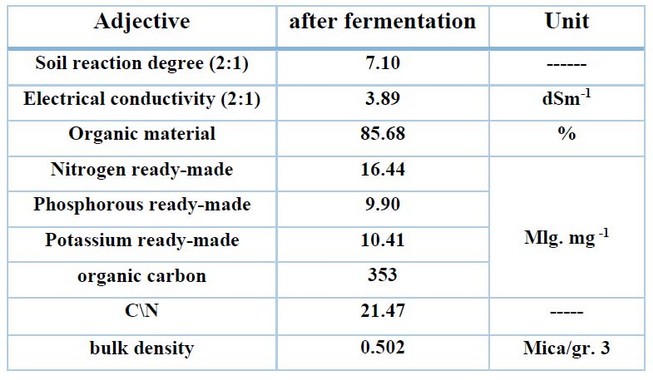
Table 1. Showing the analysis of organic matter
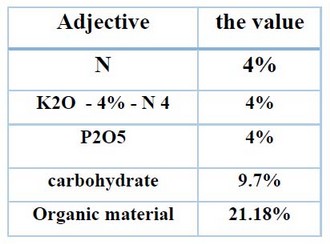
Table 2. Showing analysis of marine algae extracts.
Head weight (head-1 kg)
Five plants were randomly selected at harvest time from each experimental unit; they were weighed without the outer leaves, and then the average was calculated.
Sulfur concentration in fruits (mg -1 kg sulfur)
We take (0.2 gm)of the sample from the inflorescence discs and add a mixture of nitric acid and perchloric acid in proportions (4:9) volume. The mixture was gradually heated until a red foam of NO2 appeared, and the solution began to boil until the solution reached 3-5 ml. The solution turned Clear and colorless, cooled, and the volume was completed to 50 ml with distilled water. A spectrophotometer estimated the sulfur at a wavelength of 420 nm. The sulfur concentration was extracted from the standard curve of 7.
Nitrogen, phosphorous and Potassium concentrations in leaves
Samples were taken from the leaves of ten random plants for each treatment after the appearance of the inflorescence discs and placed in the electric oven at a temperature of (65-70) C until the stability of the weight. Then, it was crushed and placed in sealed plastic containers, and then the digestion process was carried out by taking 0.2 g of the plant sample, and it was digested according to the method proposed by 4, using sulfuric and perchloric acid. Also, 4 ml of concentrated sulfuric acid H2SO4 was added, and the sample was left for 24 hours; then, 1 ml of concentrated pyrochloric acid was added, and the digestion flasks were placed on a Hot Plate until yellow vapors appeared. Then, it was heated at a high temperature, and when the digestion process was complete, a colorless clear was obtained. Then, it was cooled, transferred to a standard flask (50) ml, and supplemented with distilled water to the mark. Later, the elements were estimated as follows:
Nitrogen was determined after adding sodium hydroxide (10 M) using a microcalcium sulfur apparatus and scaling or smashing with sulfuric acid 8.
As for phosphorous, it was estimated using modified ammonium molybdate after adjusting the reaction degree of the used solutions and measured by a spectrophotometer at a wavelength of 882 nm 28.
Potassium was determined using a flame photometer by 8.
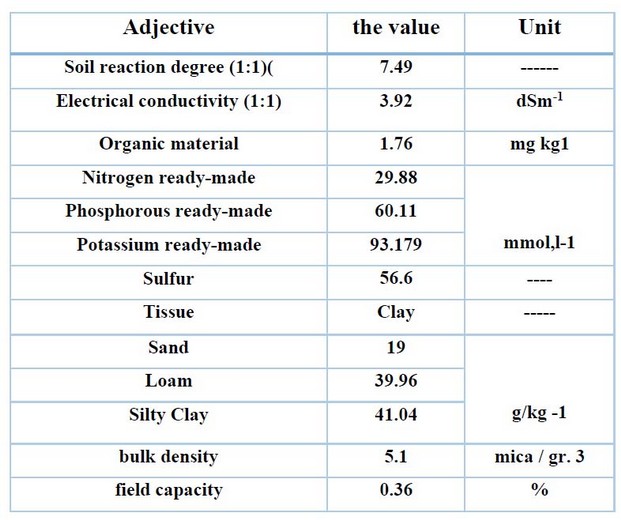
Table 3. Some chemical and physical properties of the study soil before planting
RESULTS AND DISCUSSION
Head weight (kg.plant-1)
The results of Table (4) showed that the addition of organic manure led to a significant increase in the weight of the head, which amounted to 1.611 kg for the M2 treatment (10% of the size of the terrace) compared to the unfertilized 1M treatment, which amounted to 0.734 kg. Plant-1, with an increase of (119.48% and 90.05) %) for the two treatments respectively. This may be because organic fertilizer provides the necessary elements to increase plant efficiency and improve the course of vital activities within the plant, which is reflected in the growth and active substances 3,22.
Chemical fertilization also led to an increase in head weight from 1.385 kg. Plant-1 to 1,108 kg. Plant-1, with an increase of 25%. The reason behind this may be due to Potassium, which has a significant role in plant nutrition and photosynthesis and raising the efficiency of the plant in absorbing nutrients, especially Nitrogen and phosphorous. Then, ensuring the nutritional balance process, which is positively reflected in improving plant growth and increasing its productivity 6, These results agree with the findings of 21.
The spraying of seaweed extracts led to a significant increase in head weight, which reached 1.282 and 1.284 kg Plant-1 for treatment A1 and A2 (2 and 4 ml. L-1) with an increase of 9.36 %. The reason for this may return to the increase in Seaweed extracts that increase the efficiency of nutrient uptake, root growth and thus plant growth, flowering, fruit quality, and productivity.
As for the bilateral interventions between organic and chemical fertilization significantly affected the head weight, and the interaction achieved the highest head weight in the treatment (C2M3), which amounted to 1.775 kg.plant-1 compared to the treatment that was not fertilized (C1M1), which amounted to 0.684 kg.plant-1.
The binary interactions between organic fertilization and spraying with algae extracts significantly increased head weight, which amounted to 1.447 kg. Plant-1. The highest head weight in the treatment (M3A3) compared to the treatment without fertilizer (M1A1), which reached 0.655 kg. Plant-1.
The same trend was with the bilateral interactions between chemical fertilizers and seaweed extracts, which achieved the highest head weight in the treatment (C2A3), 1.447 kg.plant-1, compared to the treatment without adding fertilizer (A1C1), which reached kg.plant-1.
As for the triple interaction, the results of the same Table showed that adding organic and chemical fertilizers and seaweed extract extracts had a significant effect on the head weight, as the treatment (A3M3C2) achieved the highest head weight of 1.853 kg. It had reached 0.603 kg. Plant-1. This increase may be due to the combined effect of the factors involved in the experiment, as they provided all the elements needed by the plant to grow well.
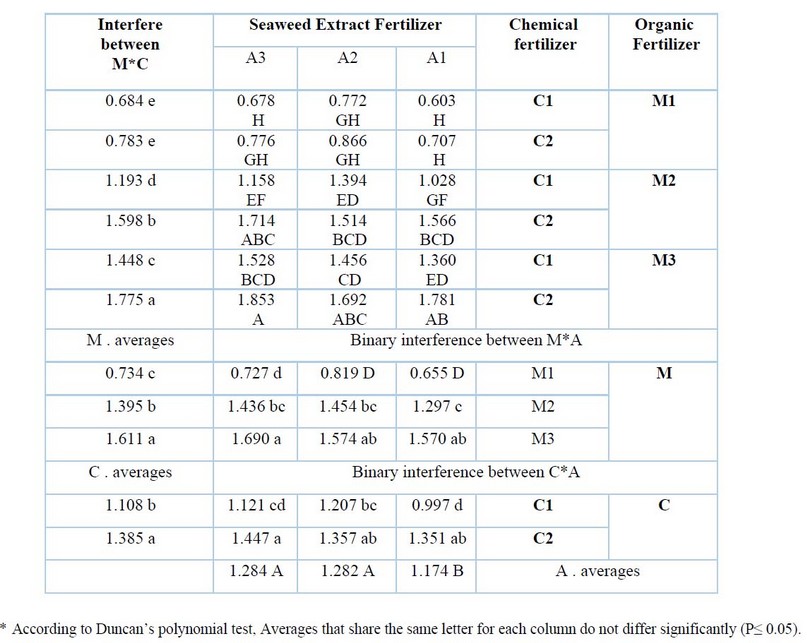
Table 4. Effect of adding chemical and organic fertilizers and spraying seaweed extracts on head weight.
Sulfur concentration in fruits (mg-1 kg sulfur))
The results of Table (5) showed that the addition of organic fertilizer led to a significant increase in the sulfur concentration in the fruits, which amounted to 1.96 and 2.00 mg sulfur kg-1 for the two treatments M2 and M3 (10 and 5% of the terracing volume) compared to the unfertilized treatment M0, which amounted to 1.611 mg sulfur kg -1 for the two treatments consecutively, with an increase of (25.49%).
The chemical fertilization also increased the sulfur concentration in the fruits from 2.00% to 1.53%, with an increase of 71.30 mg as sulfur kg-1. This may be due to the NPK chemical fertilizer containing the main significant elements that increased the sulfur concentration in the fruits.
Spraying of Seaweed extracts led to no significant differences in sulfur concentration in fruits. As for the bilateral interventions between organic and chemical fertilization, they significantly affected the concentration of sulfur in fruits. As well as the interaction achieved the highest concentration of sulfur in fruits in the treatment (C2M3) and (C2M2), which amounted to 2.29 and 2.16 mg of sulfur kg-1 compared to the treatment that was not fertilized (C1M1), which amounted to 1.12.
The bilateral interactions between organic fertilization and spraying with seaweed extracts achieved a significant increase in sulfur concentration in fruits, which reached 2.12 and 2.11 mg sulfur kg-1, which is the highest sulfur concentration in fruits for the treatment (M3A2) and (M2A2) compared to the treatment that did not add the fertilizer (M1A1). It reached 1.22 mg sulfate kg-1.
The same trend was observed with the bilateral interactions between chemical fertilizers and seaweed extracts, which achieved the highest concentration of sulfur in fruits in the two treatments (C2A2) and (C2A2), which amounted to 2.08 and 2.04 mg of sulfur kg-1 compared to the treatment that did not add the fertilizer (A1C1), which It reached 1.37 mg as sulfate kg-1.
As for the triple interaction, the results of the same Table showed that adding organic and chemical fertilizers and seaweed extracts had a significant effect on the sulfur concentration in the fruits. As the treatment (M3C2A1) achieved the highest sulfur concentration in the fruits, which amounted to 2.81 mg sulfur kg-1. It was significantly superior to the treatment that did not fertilize (M1C1A1) and reached 0.99 mg as sulfate kg-1. This increase may be due to the combined effect of the factors involved in the experiment, as they provided all the elements needed by the plant to grow well.
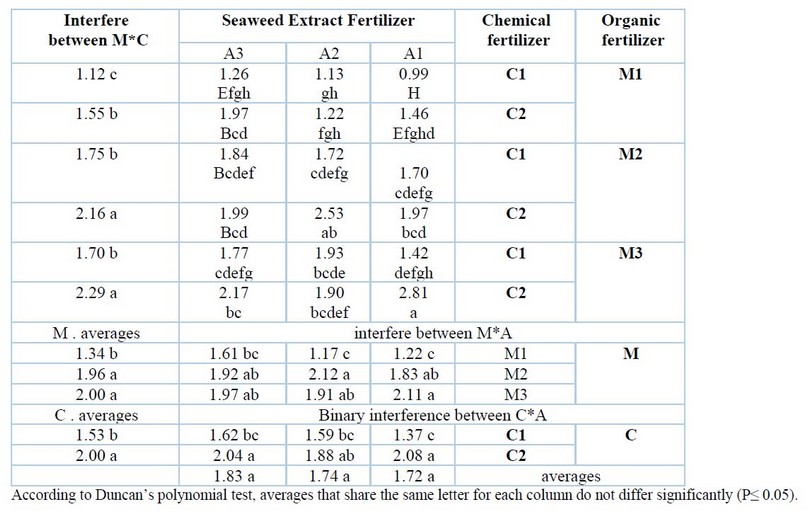
Table 5. Effect of adding chemical and organic fertilizers and spraying seaweed extracts on fruit sulfur concentration.
Nitrogen concentration in leaves (%)
The results of Table (6) showed that the addition of organic fertilizer led to a significant increase in the nitrogen concentration in the leaves, which reached 4.68% and 4.33% for the two treatments, M2 and 3M (5 and 10% of the size of the terrace) compared to the unfertilized treatment M0 which amounted to 3.64% and an increase of (57.28). The reason for the superiority of organic fertilizer in increasing the percentage of Nitrogen in the leaves may be attributed to the fact that the organic fertilizer contains important stores of Nitrogen, phosphorous, Potassium and iron, as the use of organic fertilizers leads to an increase in the readiness of these elements (Fe, K, P, N) in the leaves. These results agree with the findings 19.
Chemical fertilization also increased the concentration of Nitrogen in the leaves from 4.60% to 3.48%, with an increase of 19.79%. The increase in the percentage of Nitrogen in the leaves may be due to the readiness of this element in the soil and to the plant’s need for Nitrogen, especially in the early stages of its growth to increase vegetative growth. Also, Nitrogen is considered one of the fast-moving elements inside the plant, which led to its rapid transfer and accumulation in the leaves of the plant 18
Spraying of seaweed extracts led to significant differences in the nitrogen concentration in the leaves, as the highest value reached 4.61% for treatment 3A (concentration 6 mmol. L-1), and the lowest value was 3.80% for treatment 1A with an increase of (21.31 and 57.11%). The reason for this increase is the richness of seaweed extracts of nutrients and plant hormones and their physiological role in balancing the vital processes of the plant. This will increase the concentration of Nitrogen in the leaves 16.
The bilateral interventions between organic and chemical fertilization significantly affected the nitrogen concentration in the leaves, and the interaction achieved the highest nitrogen concentration in the leaves in the treatment (C2M3). It amounted to 5.28% compared to the treatment that was not fertilized (C1M1), and it amounted to 3.50%.
The bilateral interactions between organic fertilization and spraying with seaweed extracts significantly increased the nitrogen concentration in the leaves, reaching 5.07, 5.32 and 4.82%. (M1A1) as it reached 3.54%.
The bilateral interactions between organic fertilization and spraying with seaweed extracts significantly increased the nitrogen concentration in the leaves, reaching 5.07, 5.32 and 4.82%. (M1A1) as it gained 3.54%.
As for the triple interaction, the results of the same Table showed that adding organic, chemical fertilizers, and seaweed extracts had a significant effect on the nitrogen concentration in the leaves. The treatment (M3C2A3) achieved the highest nitrogen concentration in the leaves, reaching 6.30%. It was significantly superior to the not-fertilized treatment (M1C1A1). It reached 3.20%. This increase may be due to the combined effect of the factors involved in the experiment, as they provided all the elements needed by the plant to grow well.

Table 6. Effect of adding chemical and organic fertilizers and spraying seaweed extracts on leaf nitrogen concentration.
The concentration of phosphorous in the leaves (%).
Table (7) showed that adding organic fertilizer led to a significant increase in phosphorous concentration in the leaves. It reached 0.39% for the M3 treatment (10% of the terrace size) compared to the non-fertilized treatment M0, which amounted to 0.25% and an increase of (56%). This may be because organic fertilizer is an essential nitrogen source in building proteins, enzymes and energy processing, encouraging vegetative and root growth. Its addition leads to an increase and expansion of cell divisions, and the rise in Nitrogen increases the availability of phosphorous and stimulates and encourages the uptake of phosphorus by plant roots through increasing vegetative and root growth. These results are in agreement.
Chemical fertilization also increased the phosphorous concentration in the leaves from 0.37% to 0.26%, with an increase of 30.42%. This may be due to the availability of phosphorous and Nitrogen element, which stimulates and encourage the plant and regulates several vital activities the plant needs 25. These results are in agreement with 5,26,27. Spraying of seaweed extracts resulted in no significant differences in the concentration of phosphorous in the leaves between the experimental treatments.
The bilateral interventions between organic and chemical fertilization significantly affected the phosphorus concentration in the leaves. The interaction achieved the highest phosphorus concentration in the leaves in the treatment (C2M3), which amounted to 0.47%, compared to the treatment that was not fertilized (C1M1), which amounted to 0.20%.
The binary interactions between organic fertilization and spraying with seaweed extracts achieved a significant increase in the phosphorous concentration in the treatment (M3A3), (M2A2) and (2M1A), compared to the treatment that did not add the fertilizer (M1A1), it amounted to 0.21%.
The same trend was with the bilateral interactions between chemical fertilizers and seaweed extracts, which achieved the highest concentration of phosphorous in leaves in treatments (A3C2), which amounted to 0.36, 0.40 and 0.37% compared to the treatment that did not add fertilizer (A1C1), which amounted to 0.24%.
As for the triple interaction, the results of the same Table showed that adding organic and chemical fertilizers and seaweed extracts had a significant effect on the phosphorous concentration in the leaves. The two treatments (M3C2A2) and (M3C2A3) achieved the highest phosphorous concentration in the leaves, which amounted to 0.49% and 0.47%. They were significantly superior to the treatment that was not fertilized (M1C1A1), which amounted to 0.16%. This increase may be due to the combined effect of the incoming factors in the experiment. It provided all the elements needed by the plant to grow well.

Table 7. Effect of adding chemical and organic fertilizers and spraying seaweed extracts on phosphorous concentration in leaves.
Iteration in leaves (%)
The results of Table (8) showed that the addition of organic fertilizer led to a significant increase in the potassium concentration in the leaves, which amounted to 2.99% for the M3 treatment (10% of the size of the terrace) compared to the unfertilized treatment M0, which amounted to 2.05%, with an increase of (85.45 and 41.23%). This may be due to the large area occupied by the plant, which leads to a rise in the spread of the plant’s root system in the most expansive area. This will give it a wider field for growth and absorption of elements and nutrients. These results agree with 14.
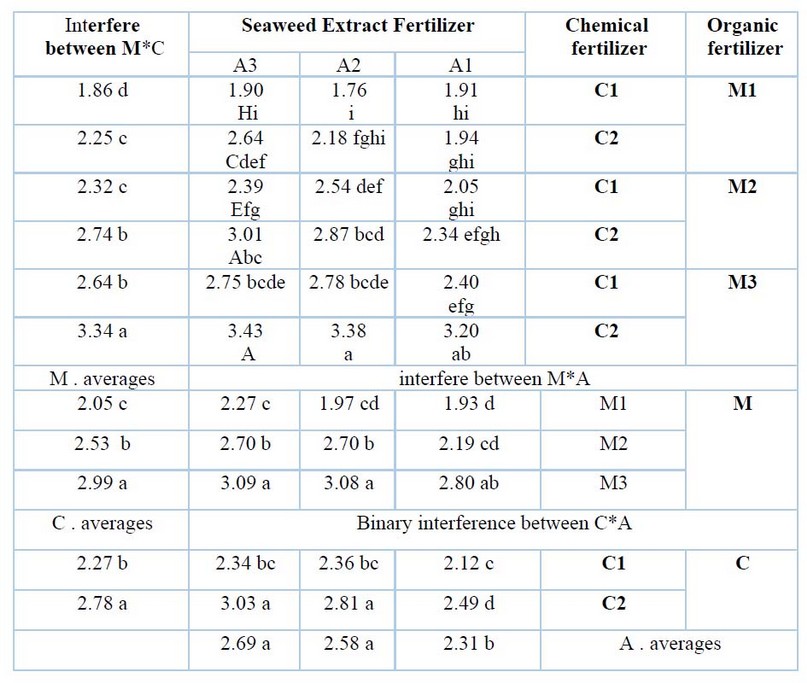
Table 8. Effect of adding chemical and organic fertilizers and spraying seaweed extracts
DISCUSSION
The chemical fertilization also increased the potassium concentration in the leaves from 2.78% to 2.27%, with an increase of 46.22%. This may be due to the rise in the percentage of Potassium in the leaves, the readiness of this element in the soil, and the plant’s need for Nitrogen.Especially in the early stages of its growth to increase vegetative growth. Also, Nitrogen is considered one of the fast-moving elements inside the plant, which led to its rapid transfer and accumulation in the plant leaves; these results agree with the findings of 20. Spraying seaweed extracts led to significant differences in potassium concentration in leaves, as the highest value reached 2.58% and 2.69% for treatment A3 and A2 (4 and 6 mmol.l-1), and the lowest value reached 2.31% for treatment A1 with an increase of (13.28%). This increase is due to the richness of seaweed extracts of nutrients and plant hormones and their physiological role in balancing the vital processes of the plant. Thus increasing the concentration of Potassium in the leaves 16. As for the bilateral interventions between organic and chemical fertilization, it significantly affected the potassium concentration in the leaves. The interaction achieved the highest potassium concentration in the leaves in the treatment of (C2M3), which amounted to 3.34%, compared to the treatment that was not fertilized (C1M1), which amounted to 1.86%. The dual interactions between organic fertilization and spraying with seaweed extracts significantly increased the Potassium concentration in the leaves, which reached 2.81% and 3.03%, which gained 1.93%. The same trend was observed with the bilateral interactions between chemical fertilizers and seaweed extracts, which achieved the highest potassium concentration in the leaves in treatments (A3C2) and (C2A2), which amounted to 2.81 and 3.03% compared to the treatment that did not add fertilizer (A1C1), which amounted to 2.12%. As for the triple interaction, the results of the same Table showed that adding organic, chemical fertilizers and seaweed extracts had a significant effect on the potassium concentration in the leaves. So the two treatments (M3C2A2) and (M3C2A3) achieved the highest potassium concentration in the leaves, reaching 3.38 and 3.34%. They significantly outperformed the treatments that were not fertilized (M1C1A2), which amounted to 1.76%. This increase may be due to the combined effect of the factors involved in the experiment, as they provided all the elements needed by the plant to grow well.
CONCLUSIONS
Adding organic fertilizer (10% of the size of the terracing), led to a significant increase in all the studied traits. It used chemical fertilization to fertilize cauliflower for its significant superiority in all studied features. The use of a foliar spray of seaweed extracts at concentrations (4 and 6 mmol.L-1) for its significant excellence in most studied traits.
REFERENCES
1. Bhatt, S., Singh, B., & Gupta, M. Antioxidant and prebiotic potential of Murrayakoenigii and Brassica oleracea var. botrytis leaves as food ingredient. 2020; Journal of Agriculture and Food Research, 2, 100069.
2. Boateng, V. F., Donkoh, S. A., &Adzawla, W. 2022. Organic and conventional vegetable production in northern Ghana: farmers’ decision making and technical efficiency. Organic Agriculture, 1-15.
3. Bergstrand, K. J. Organic fertilizers in greenhouse production systems–a review. 2022; Scientia Horticulturae, 295, 110855.
4. Cresser, M.S. and J.W. Parsons. Sulphuric, perchloric acid and digestion of plant material for determination of Nitrogen, phosphorus, Potassium, calcium and magnesium. 1979; Analytical Chemical. Acta. 109:431-436.
5. El-Shafie, H. A. F. Impacts of Organic Farming on Insects Abundance and Diversity. 2022; In Global Decline of Insects. IntechOpen.
6. Gonçalves, Y. D. S., Freitas, M. S. M., Carvalho, A. J. C. D., Vieira, M. E., Peçanha, D. A., Cunha, J. M., & dos Santos, P. C. Potassium sources impact on cassava plant productivity, quality and mineral composition. 2022; Journal of Plant Nutrition, 45(1), 86-94.
7. Hammed,H.A; F.M. Abid, and A.W.R. Hamad. Determination of Iraq(Nigellasativa L.)seed by Atomic absorption spetorphoto meteriraqi; 2002; J. Of chem. Vol.28, No(1).
8. Haynes, R.J. A comparison of two modified kjeldhal digestion techniques for multi-element plant analysis with conventional wet and dry ashing methods . 1980; Comm. Soil .Sci. Plant Analysis .11(5): 459-467.
9. Kareem, A., Farooqi, Z. U. R., Kalsom, A., Mohy-Ud-Din, W., Hussain, M. M., Raza, M., &Khursheed, M. M.Organic Farming for Sustainable Soil Use, Management, Food Production and Climate Change Mitigation.In 2022; Sustainable Agriculture (pp. 39-59). Springer, Cham.
10. Pradhan, B., Bhuyan, P. P., Patra, S., Nayak, R., Behera, P. K., Behera, C. Jena, M. Beneficial effects of seaweeds and seaweed-derived bioactive compounds: Current evidence and future prospective. 2022; Biocatalysis and Agricultural Biotechnology, 39, 102242.
11. Koss‐Mikołajczyk, I., Kusznierewicz, B., Wiczkowski, W., Płatosz, N., &Bartoszek, A. Phytochemical composition and biological activities of differently pigmented cabbage (Brassica oleracea var. capitata) and cauliflower (Brassica oleracea var. botrytis) varieties. 2019; Journal of the Science of Food and Agriculture, 99(12), 5499-5507.
12. Mahapatra, D. M., Satapathy, K. C., & Panda, B. Biofertilizers and nanofertilizers for sustainable agriculture: Phycoprospectsand challenges. 2022; Science of The Total Environment, 803, 149990.
13. Montgomery, D. R., Biklé, A., Archuleta, R., Brown, P., & Jordan, J. Soil health and nutrient density: preliminary comparison of regenerative and conventional farming. 2022; PeerJ, 10, e12848.
14. Sharma, D. K. ; D. R. Chaudhary and D. P. Pandey. Growth and yield of lettuce cv. “Alamo-1” was influenced by dates of planting and plant density. 2001; Vegetable Science. 28 (1):38-39.
15. Singh, S., &Kalia, P. Advances in Cauliflower (Brassica oleraceavar. botrytis L.)Breeding, with Emphasis on India. In Advances in Plant Breeding Strategies: 2021; Vegetable Crops (pp. 247-301). Springer, Cham.
16. Weeraddana, C. D. S. Extracts of The Brown Seaweed, Ascophyllum Nodosum, Effect Arabidopsis ThalIana – Myzus persicae Interaction. 2012; MS.Thesis, College of Agricultural. Scotia.
17. Zeb, A., Khan, S., &Ercişli, S. Characterization of carotenoids, chlorophylls, total phenolic compounds, and antioxidant activity of Brassica oleracea L var. 2022; botrytis leaves from Pakistan. Biologia, 1-10.
18. Abu Dahi, Yusuf Muhammad, Muayad Ahmad Al-Younis. Guide to Plant Nutrition, Directorate of Dar Al-Kutub for Printing and Publishing, 1989; University of Mosul, Ministry of Higher Education and Scientific Research.
19. Al-Khafaji, Aseel Muhammad Hassan, Tel. Effect of organic fertilization from different sources on the growth, yield and quality of contact and seed onion plant. 2010; Master Thesis - Department of Horticulture - College of Agriculture - University of Baghdad.
20. Al-Zuhairy, H. T. H., & AL-Hamdany, S. A. Effect of organic, chemical fertilizers and plant density on 2-some growth and yield characteristics of cauliflower Brassica oleracea var. botrytis. 2017; Diyala Agricultural Sciences Journal, 9(2), 104-114.
21. Abdulrasool, K. J., & Hamid, R. R. Effect of mineral fertilizers and soil amendments and fertilizer application methods on reducing ammonia volatilization and growth and cabbage yield. 2020; Diyala Journal of Agricultural Sciences, 12(A special issue of the proceedings of the Fourth Scientific Conference on Agricultural Research).
22. Verma, R.; Maurya, B.R.; Meena, V.S.; Dotaniya, M.L.; Deewan, P. and Jajoria, M. Enhancing Production Potential Of Cabbage And Improves Soil Fertility Status Of Indo-Gangetic Plain Through Application Of Bio Organics And Mineral Fertilizer. International 2017; Journal Of Current Microbiology And Applied Sciences, 6(3): 301-309.
23. Shekari, G., Javanmardi, J. Effects of Foliar Application Pure Amino Acid and Amino Acid Containing Fertilizer on Broccoli (Brassica oleracea L. var. italica) Transplant. 2017; Adv Crop Sci Tech 5(3):1-4.
24. Teixeira, W.F. ; Fagan, E.B. ; Soares, L.H. ; Umburanas, R.C. ; Reichardt, K. and Neto, D.D. Foliar and Seed Application of Amino Acids Affects the Antioxidant Metabolism of the Soybean Crop. 2017; Front. Plant Sci. 8:327.
25. Al-Sahhaf, Fadel Hussein, Suad Muhammad Khalaf, Iman Mahmoud. The effect of integrating ground fertilization and spraying with organic and chemical fertilizers on the content of leaves and discs of N, P, K and nitrate concentration and yield in cauliflower, Al Furat 2012; Journal for Agricultural Sciences 4(2): 31-21.
26. Al-Zamili, Naseer Fahim Yasser.2012. The role of organic and chemical nutrients in the growth and production of cauliflower. Master’s Thesis, College of Agriculture, University of Baghdad.
27. Junaid, Saba Sobhi Khamis. Effect of fertilizer type on vegetative growth and yield in three cauliflower crosses. 2015; Master Thesis. College of Agriculture, Diyala University.
28. Olsen, S. R., & Sommers, L. E. Phosphorus. p. 403–430. AL Page et al.(ed.) Methods of soil analysis. Part 2. 1982; Agron. Monogr. 9. ASA and SSSA, Madison, WI. Phosphorus. p. 403–430. In AL Page et al.(ed.) Methods of soil analysis. Part 2. 2nd ed. Agron. Monogr. 9. ASA and SSSA, Madison, WI.
Received: May 15, 2023/ Accepted: June 10, 2023 / Published: June 15, 2023
Citation: Saleh Auf. Bader, Basem. Effect of adding chemical and organic fertilizers and spraying seaweed extracts on NPKS concentrations and cauliflower yield. Revis Bionatura 2023;8 (2) 93. http://dx.doi.org/10.21931/RB/2023.08.02.93
